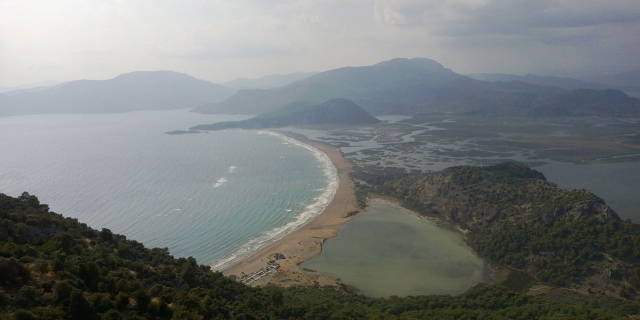Telmessos or Telmessus (Hittite: 𒆪𒉿𒆷𒉺𒀸𒊭 Kuwalapašša, Lycian: 𐊗𐊁𐊍𐊁𐊂𐊁𐊛𐊆 Telebehi, Ancient Greek: Τελμησσός), also Telmissus (Ancient Greek: Τελμισσός), later Anastasiopolis (Ancient Greek: Αναστασιούπολις), then Makri or Macre (Greek: Μάκρη), was the largest city in Lycia, near the Carian border, and is sometimes confused with Telmessos in Caria. It was called Telebehi in the Lycian language. The well-protected harbor of Telmessos is separated from the Gulf of Telmessos by an island.
The name of the modern town on the site is Fethiye.
The city was known as Kuwalapašša by the Hittites and Telebehi by the Lycians.[1] According to the annals of Hattusili III, the city was a part of Lycia (which was known as Lukka at the time) and conquered by the Hittites. Another Hittite document mentions the cities of Kuwalapašša and Dalawa sent aid to Hittites during the war against Iyalanda.[2]
Telmessos was a flourishing city in the west of Lycia, on the Gulf of Fethiye. It was famed for its school of diviners, consulted among others by the Lydian king Croesus, prior to declaring war against Cyrus, and by Alexander the Great, when he came to the town after the siege of Halicarnassus.
Telmessos was a member of the Delian League in the 5th century BC. It was taken by Alexander in 334 BC.
Telmessos was renamed Anastasiopolis in the 8th century AD, apparently in honour of Emperor Anastasios II, but this name did not persist. The city came to be called Makri, after the name of the island at the entrance to the harbor. This name is attested for the first time in 879 AD.
However, an inscription of the 7th century found in Gibraltar and bearing the ethnonym "Makriotes" (from Makri) may indicate an earlier existence of name Makri.[3]
Its ruins are located at Fethiye.



























Add new comment